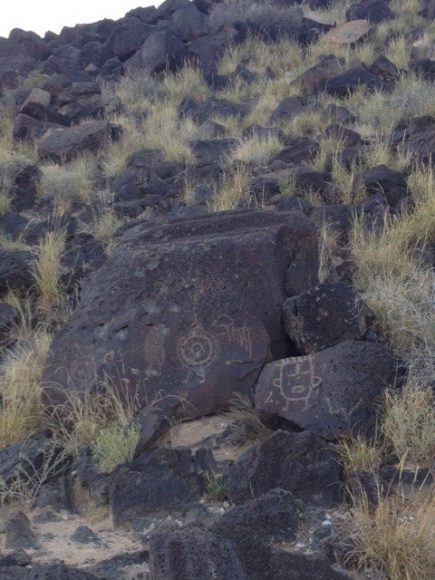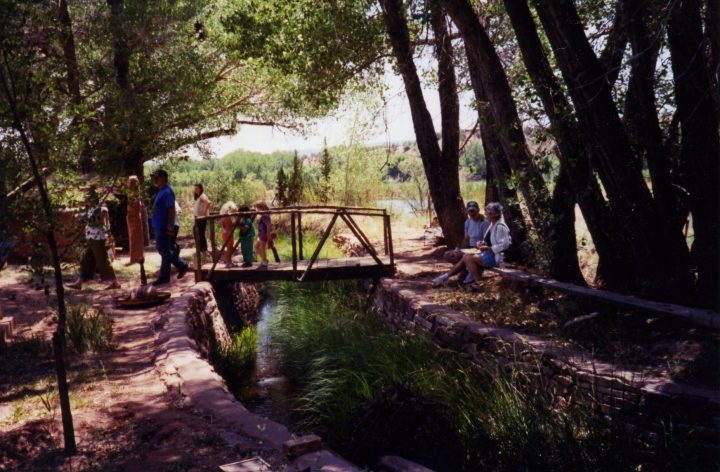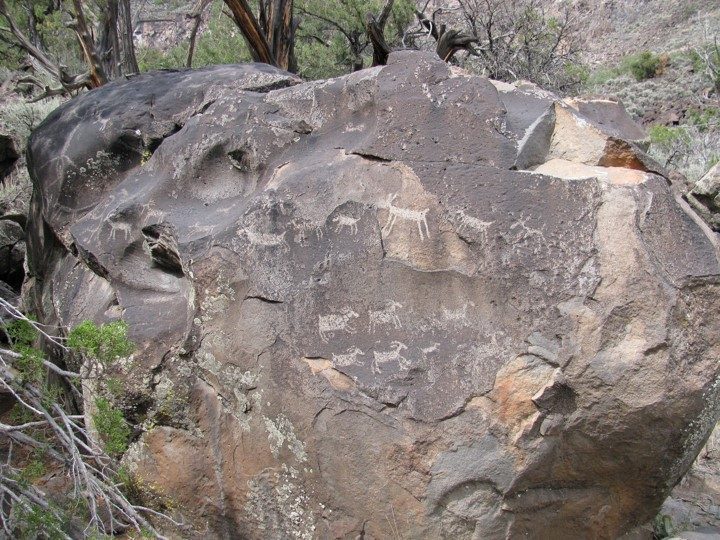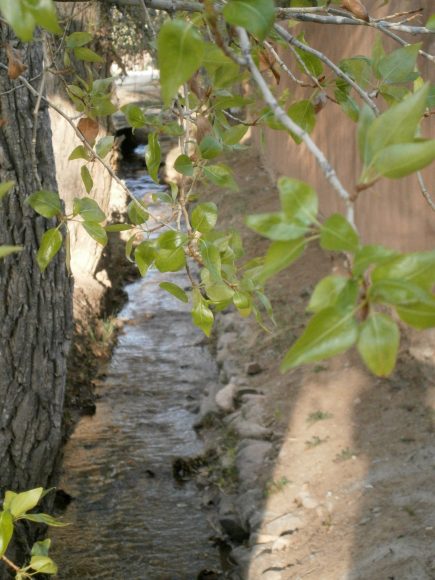We too are wild
In the past year we have seen hundreds of kangaroos flee bush fires in Australia, half a billion birds and reptiles perish, and many people lose their homes or in some cases, their lives. As well, violence continues to erupt all over our own continent of North America, among humans who have lost their cultural grounding. We are being forced to realize that our lives, our bodies, belong to the earth and its shifting life conditions. We have often presumed to be separate from the web of nature. We are not. We too are wild. Water and flesh, cells and blood, we are of that physical world, that matter which a Western-European mindset has constantly sought to dominate.
Since the Industrial Revolution, we have steadily distanced ourselves and our cultures from the places that have allowed us a shared reverence for our surroundings. In the 1930s, Franklin D. Roosevelt’s New Deal structured a valuable and wide-reaching bureaucracy that brought great relief and recovery to US society after the Depression. Canada followed a similar development after World War II, but neither country has known how to limit institutional control. By the end of the 20th century, bureaucracy had become technocracy, with increased government and corporate codification and control of individual lives. A “modern” and urbanizing society leading to more and more people being distanced from the birds, the herds and the forest; distanced too from their own learning and meaning and its resonance with all that lives. With computer technology, this tendency to control has increased, as Philip Cross, a Munk Senior Fellow at the Macdonald-Laurier Institute, pointed out in his article in the Financial Post on March 27, 2019:
Condemning people to conform to a life shaped by algorithms and regulations ignores how individuals respond differently to the fundamental question posed by Goethe “On what terms is life worth living?”
“I want to tell what the forests were like”
While coordinating the Taos Conference on Writing and the Natural World for Recursos de Santa Fe in 1991, I had the privilege and joy of meeting the poet W.S. Merwin. Our conversations and his poems reflected the degree to which life is worth living and the earth worth caring for, but he felt there was little reason to be optimistic for the planet. We were already late, too late perhaps, in our awareness.
Today I go back to lines from his poem “Witness” where he ponders telling “what the forests were like.” His disquieting conclusion is that “[he] will have to speak in a forgotten language.” (W.S. Merwin, The Rain in the Trees, 1988)
These words were moving for me then, but are frighteningly real now, echoing the loss of great swaths and depths of land and water, unprecedented extinction of species and the undermining of our own bodies, our own breath, our own communities.
But in spite of the damage to so much habitat, in 2020, in this lifespan where we are still surviving, it is crucial for us, our children and those who follow to restore a relationship with the earth that is worthy of our hope, worthy of their very new lives. Their newness in some ways is their wildness, as is the naturalness of their growth and their responsiveness to the world.
For that vitality to stay alive in them, to keep the presence of human breath and tenderness valued in their societies, they will need to know the beauty of the earth and their belonging to it, to be able to co-habit with the wild animals, breathe the oxygen of forests, wonder at the myriad forms of life among the birds of the air, the insects and planets, the stars and berries. They will need to learn from the diversity of nature’s intricate workings.
Richard Louv’s moving book, Last Child in the Woods: Saving Our Children from Nature Deficit-Disorder, vividly documents the difficulty of doing this for today’s children. However, the generation whose dilemma Louv spoke of in 2006 has now reached adolescence and includes some of the young people who are speaking out and marching with Greta Thunberg, gathering together to lead the way to change. For the living world to oxygenize their lives spiritually and physically in this new millennium, the need for places, people and stories that nurture and cherish wildness remains. They are hungry for it.
The challenge, though, also remains, deep within a cultural mindset that views nature as indifferent to us, like the avalanche that thunders down upon a few vulnerable mountain-climbers’ bodies. Mind, money and machine are deployed to dominate its force. Mind over matter and now money over matter are the tenets that organize our society’s presumptuousness to push for this impossible ambition.
The communal spirit is alive
Our dominant mindset does not account for or value reciprocity with nature. It ignores collaboration with the life force manifest in the wind as sailors and poets may know it, or in the whitewater as kayakers may know it, and attaches little value to the movement of the deer as traditional First Nations’ hunters know it. The peoples and their traditions, stories and works of art that witness such meanings are often overlooked or dismissed… considered too difficult to quantify or too sentimental or superstitious for a culture that still prefers the often blind drive of exploitation to the rapport (that “sympatico”) with life-engendering forces.
That reciprocity with nature is alive in the acequia tradition* in northern New Mexico, where for 400 years villagers, farmers, and in modern times, city dwellers, have gathered every spring under the helpful eye of the local comisiando (elected water commissioner), to clean las acequias, a network of narrow irrigation ditches that carry the runoff from the mountain snows to thirsty gardens, trees and farms. Community-owned, the acequias nourish not only the soil, food and flowers of the land, but our own kinship with the water and one another as well. It is a moving commons.
Ancient petroglyph sites in the Americas also mark people’s relationship with place: their hunting experiences and rituals, their social structure, their knowledge of water sources, solstices and even supernovas. In the American Southwest, the rock art reflects worldviews 1,000 to 6,000 years old connecting them (and us, thankfully) to the land and to our long and varied human history with one another and our fellow animals. Yet, as a professional guide leading archaeologists and respectful visitors through these sites, I have witnessed “protection” policies in some National Parks – the only natural commons many citizens know – that are maintained by a law enforcement staff more skilled in bureaucratic or military organization than knowledgeable about this history or the variety of life forms they are hired to protect.
Wild life – our life – sprouts and bleeds, breathes and speaks within the physical world. But caught up in our attempts at control, we are deeply afraid and thus inclined to keep extending this fissure in our cultural mindset even to our very own protected spaces. Our efficiency and management succeed all too often in separating us from our limited heritage of the wild.
This land of solitude and solidarity
Growing up in a semi-rural city with ranching relatives not far, I was fortunate to experience how small, settled populations can live together with the gentle and demanding freedoms offered by earth-based values and practices. In spite of the horrors of historical conflict in the American Southwest, these values have held through respect and shared reverence for the mountains and deserts, along with a quiet joy in how we live with their beauty, the climate, the terrain and the wildlife. The well-developed traditional insights of the Native, Hispanic and Anglo peoples in the area are finely attuned to the complexities of the region’s climate and habitats, and remain today carriers of regeneration. New agrarians, young ranchers and farmers collaborate, based on their elders’ knowledge and that of ecologists, to offer us healthy food.
It is a reflection of the general society’s cultural dichotomies and of the debilitating urban-rural divide that this quieter way of life has rarely been visible to those from the more urban East coasts of North America who have often only seen the violence engendered by the harsh conditions and the depictions of cowboy, Indian or animal ruthlessness pictured in films. In reality, as of the 60s, the area had been subject to oil and gas development but in more recent years, fracking has led to more western land being lost to that industry. Then in the 1980s, the adobe architecture of Santa Fe Style became popular, leading to a new influx of real estate developers and the migrant wealthy from Hollywood, Chicago, Boston, New York and particularly Los Angeles. Many of the recent arrivals had never known the tacit bonds of the culture they were coming to, and often set about appropriating its beauty, homes, land and art to enhance their own image, putting this land of solitude and solidarity in the wide-open spaces at risk. The palpable sorrow felt among many is not that there is no last frontier but that the cultural habitat is being lost along with the landscapes threatened or destroyed by real estate and fracking.
The Trump administration has worsened the situation, taking over public lands and First Nations’ sacred sites for the purpose of industrializing the land for uranium mining and the oil and gas industry. The threatened areas include Bears Ear National Monument, where an agreement between the federal government and five First Nations (the Navajo, the Hopi, the Ute Mountain Ute, the Ute of the Uintah and Ouray Reserve, and the Pueblo of Zuni) was developed in exemplary collaboration with Obama’s administration. Having been a main focus of Trump’s destruction of public lands, the protected land of this iconic area has now been reduced by 85%.
“The end of living and the beginning of survival”
What are we to do then, at this time of the end of living and the beginning of survival (Chief Seattle)? How are we and our children to know the earth?
Protect migration corridors and National Parks. Tend gardens. Clean the acequias and the St. Lawrence shore. Wonder and wander in meadows. Learn about the soil and birds, insects and flowers. Respect peat bogs and tidal marshes. Restore natural corridors in cities for children’s play. Embrace the wild within us. Defend the commons we know. Cherish. Speak. Walk. Act. Care for the fragmented landscapes and littered shores. Together.
The places that shelter natural habitats and their species are the same places that shelter the possibility of our experience of the sacred, our deeper intuitive knowledge of what it is and how it is to be alive – alive in these bodies, alive with this earth. These places that we often call “refuge” or “sanctuary.” Sanctuary, as the dictionary says, is a place recognized as holy. Space that not only aids the birds’ survival but our own.
If we allow these shelters to be places where we re-experience and acknowledge, privately and collectively, our life-kindness with the land and animals, we will have found a place where we can be sacred too, where we can breathe with respect for our own wildness as part of a larger breath. We will have found a place to recognize the holy fragility of our own survival.
Is life really worth living if we deprive ourselves of the ground for intimacy with the wild? Sever ourselves from these places where our own intuitions can come to know nature’s rhythms and wildlife on their own terms? If we distance ourselves, as we have, from the people who carry the nuances of thought and mindful tenderness that come from a long practice of attention to the land? Continuing to do so, we risk never meeting the yet unuttered possibilities for understanding and balance that can be the foundation of more extensive, more subtle and bonding knowledge of the planet for our children and the health of our futures.
What are the circumstances that we need to survive, to live again? We need each other and the land that speaks to us of life other than our own. We need the tides and the shores of our planet; we need the forests and the hills, the plains and the rain, the elk, the mountain lion, the jackrabbits, the sea, the snow, the beluga and the bees. Without them, our efforts to renew our world can only limp along, stumble or fail. We are necessary to their survival. They are as necessary to ours.
Scientists prove neuromuscular sympathies between dancers and their audience and animals and their owners, studying as well the health of plants, which flourish when spoken to regularly. Separate from people’s daily lives, we document these experiences in laboratories where spring water is proven to be more beneficial to health than tap water. Much lab work is done to uncover the whys and wherefores of a natural balance. But beyond the laboratory, it is excruciatingly apparent that the earth and those whose lives are led in relationship with it are met with an impenetrable shield of insensitivity and fear.
Rural and Indigenous traditions are deeply rooted
Still, we can trust that many rural and Indigenous traditions are more deeply rooted than we dare believe, as are our own senses. For sentient beings that we are, frequent, direct and respectful experience with the earth’s trees, deserts and waters carries with it a broad complex of subtle and ingenious knowledge, affording as well peaceful hearts, clear insight, and sometimes restored health. The Japanese tradition of forest bathing speaks of this.
In the laboratory, decades at least will be needed to document and indeed substantiate our understanding of this. But time is crucial. Our species’ survival is threatened along with that of others. We must value the intelligence of our senses now, reclaim them, trust them now, revive and nourish them through contact with and understanding of the earth. We must value and collaborate with the store of traditions within the cultures of the Americas that offer articulate ways of knowing that the dominant culture has refused to value.
The Creation Stories of the Pueblo end with the four tribes being sent out upon the earth to sing and dance the Stories to keep the balance according to the dictates of all beings on the earth. Here, the humans are part and parcel of the process with the living earth and are responsible to it. They are entrusted with restoring its imbalances to coherence and beauty. Fortunately, the Corn, Deer and Buffalo Dances, along with other rituals held in the village plazas, still allow the 19 Pueblo communities and their friends who gather there to do so.
In our larger North American society, though, too few people have access to such rituals in a longstanding commons. Having lost our restorative ways, we find ourselves, sometimes complicit, pressured by a society based on power and control, ironically more and more fragile, dependent on money, more and more desperate, while government, corporations and industries exhaust the edges of our own and the earth’s resources. Many of us eye the brink of despair, sensing our own disassociation from the renewable resources of life, knowing unwittingly the disastrous consequences of our collective violation and pillaging of them.
Protecting the commons where it can still be found
Fortunately, in their reporting over the last two years, The Guardian, the CBC, NPR and others have begun to recognize and validate the grief that all people, not only the young, are experiencing in these times of the earth’s upheaval. Such recognition is beneficial as Greta Thunberg continues to give voice to the necessity to act. The September 2019 climate strike allowed many to express their own grief, as did 19-year-old Stacey Petrov from Wagner College. “… we’re grieving our home,” she says. “We don’t see endangered animals and think, oh, that’s so sad, they’re gonna die. We see ourselves as endangered animals because if this doesn’t get fixed in the next five years, we are going to die, or there’s going to be mass chaos.” It is imperative to counter despair by protecting the commons where it can still be found.
Vigilance, though, is called for as both generations try to earn the trust for the future we carry. People flocking to fragmented wilderness areas seeking discovery, transformation, wonder and wisdom must remain wary of a tendency to see “nothing” in the wild. In our hope for refuge and renewal, it is crucial to refrain from the presumptuous attitudes of the greed deep in our past and current history, usurping other traditions and using them to make exorbitantly expensive “spiritual products” that only further the impoverishment of our spirits. This tendency is the great hazard inherent in our society’s materialistic drive. We must shake off our presumption that we know it all because we have managed to package and sell it. Instead, with deliberate restraint, humbly, carefully, we must begin again to value both traditional and scientific ways of knowing, and let the recognition of our holy fragility lead us to reciprocity with the earth.
The personal integrity of our lives as living organisms, as human animals, is inextricably related to the integrity of our action, our intervention, in the world. Like a fractured spine, our culture cannot be expected to hold itself together, let alone sustain the intricacies of human muscle and tissue, if we continue to dichotomize our relationship to ourselves and to the land. If we insist on straining our resources for the purposes of power and domination, our bodies, our children, the animals, the tides and craters of our scoured earth will continue to suffer until we become deliberately attentive to the myriad life forms still alive with us on this continent.
*Note: las acequias was affectionately translated as “the beds for the water” by Estevan Arellano (Embudo, New Mexico), beloved historian, farmer, translator and scholar who died a few years ago. His work is still the main reference for las acequias traditions.












